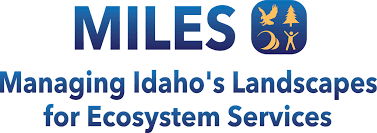Abstract
Rapid urbanization poses problems for community planners as they struggle to balance social, ecological, and economic values that often conflict with each other. While ecological and economic values, such as the annual crop yield from a farm field, are relatively easy to quantify and compare, social preferences, or the level of importance placed on different environmental resources, are often overlooked in favor of expert or influential opinions. Using results from a survey of residents in the Treasure Valley, Idaho, we explore how to better represent social preferences in a planning context.
The Project
Urbanization, or the migration from rural-suburban areas to urban areas, is increasing on a global scale and is particularly relevant in the Treasure Valley where the trend of rapidly increasing population is expected to continue. In the Intermountain West a dramatic influx of residents in the 1990s led to big changes in the Treasure Valley. Once a predominantly agricultural valley scattered with urban areas, the Treasure Valley is transitioning to a largely urbanized region. Unchecked urban growth can have unforeseen consequences on our communities and so we must start seriously considering what we want our communities to preserve. We also need to try to understand what we will need in the years to come to sustain a balance between the environment and the well-being of residents.
To better understand the tradeoffs between sociocultural, environmental, and economic values in the Treasure Valley, we turned to the Ecosystem Services Framework (ESF). The ESF was developed by researchers to simplify and present information about nature’s contribution to human well-being in a way that is applicable and useful for decision-makers. This framework calls for the quantification of ecological, economic, and sociocultural values in planning and allows us to explore tradeoffs under different scenarios.
Sounds simple, but in reality, sociocultural values are difficult to quantify and assess on scales comparable to biophysical measures, such as the degree of water quality in a watershed. In most applications of the ESF, experts or influential stakeholders often decide what’s most important from a sociocultural perspective, and traditionally use economic measures for justification. However, as urbanization increases, social values become less homogeneous and increase the likelihood of conflict regarding which issues are most important to manage for.
So how do we quantify a myriad of social values in a way that is comparable to ecological and economic measures? To tackle this problem we surveyed residents and visitors in the Treasure Valley throughout the summer in 2016. We asked respondents to choose the four most important ecosystem services (or the benefits people get from nature) from a panel and rank them according to their personal preference. We also gathered socioeconomic information along with other characteristics (like residential longevity, community involvement, etc.) thought to shape individuals’ opinions and behaviors. Using these descriptive data we can characterize groups based on people’s perceived importance of ecosystem services. This allows us to develop a simplified picture of which groups of people are concerned about specific issues. Additionally, we can use qualitative data from the survey to understand why people consider some ecosystem services more important than others. By combining quantitative and qualitative data, we can compare social preferences with ecological and economic values, and associate a narrative with those values.
The Team
Jenna Narducci, Boise State University
Jodi Brandt, Boise State University
Cristina Quintas-Soriano, Boise State University
Other Collaborators:
Dainee Gibson, Idaho State University
Antonio Castro, Idaho State University
Christian Sprague, Boise State University
Michail Fragkias, Boise State University
Funding Sources
